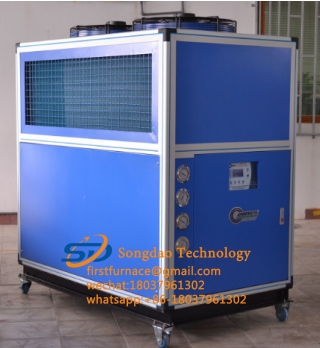- 21
- Feb
Precautions for installation of chiller refrigeration piping
Precautions for installation of chiller refrigeration piping
1. The pipes of the refrigeration system of the low-temperature chiller are all made of seamless steel pipes, and their quality shall conform to the current national standards “Seamless Steel Pipes for Fluid Transportation” (GB/T8163-2008) and “Code for Safety and Technical Supervision of Pressure Pipelines-Industrial Pipelines” (TSG) D0001-2009), select the steel grade according to the minimum working temperature in the tube. For pipelines whose warehouse design temperature is above -48°C, seamless steel pipes with steel number of 10 or 20 can be used; for pipelines with warehouse design temperature lower than -48%, seamless steel pipes with steel number of 16Mn should be used.
2. Before installing the refrigeration pipe of the chiller, the dirt and rust inside and outside the pipe must be cleaned.
3. The processing, welding and installation of pipelines shall comply with relevant regulations.
4. When the chiller is connected to the branch pipe on the main pipe of the refrigeration system, the elbow of the connection should face the flow direction of the medium in the main pipe.
5. Between the pipeline and the support and hanger with the insulation layer, between the low temperature container and the foundation, a dunnage must be set up, and the dunnage should be pre-treated with anti-corrosion.
6. When installing the valves, pressure gauges and pipe fittings of the container equipment that need to be kept cold, care should be taken not to bury them in the insulation layer of the container to facilitate future operation and maintenance.
7. The pipelines connected with auxiliary equipment such as the unit and ammonia pump should be installed firmly, and there should be no vibration during the operation of the equipment.
8. The pipeline connecting the chiller to the ammonia compressor should not be rigidly connected with the building structure.
9. The pipes connecting the ammonia compressor and equipment should have enough elbows to compensate for deformation.
10. For the elbow (elbow) processed by hot bending, the minimum bending radius is not less than 3.5 times the outer diameter of the pipe. For elbows (elbows) processed by cold bending, the minimum bending radius is not less than 4 times the outer diameter of the pipe.
11. When the installation space is limited and the installation of the large bending radius elbow of the chiller is not suitable for the installation, a pressed elbow with a bending radius of 1.5 times the nominal diameter should be used, which should comply with the “Steel Butt Welding Seamless Pipe Fittings” ( GB/T12459-2005) requirements.
12. When installing the chiller refrigeration process, the reservation work should be properly done according to the actual situation. If there is room for development, the second phase or the third phase of the later stage should be planned, and certain reservations should be made in the reserved position of the equipment, or in the liquid supply and return air conditioning station. In this way, when expanding production in the future, you can deal with it calmly.
13. When installing the refrigeration pipes of the chiller, attention should be paid to the level, beauty and no mess of the pipes, the spacing between various pipes, and the distance between various pipes and the wall. Installers should be familiar with the refrigeration process flow in the drawing, know the purpose of each pipe, and consider the convenience of heat preservation, operation and maintenance in the future, and should be familiar with the flow direction and wave direction of the working fluid in the process pipe.
14. Now the low-pressure circulating barrels and ice-making pools of some refrigerated enterprises are not easy to drain oil. This is because there are impurities in the tube and the low temperature in the tube is not easy to drain the oil. Therefore, hot ammonia pressure treatment should be added to the oil drain design of the oil bag of the low-pressure circulating barrel and the ice-making pool. If there is no setting in the design, a hot ammonia pressurized pipeline should be added during installation to facilitate smooth oil discharge.
15. After the installation of the chiller pipeline, in addition to the pressure test, leak test and other procedures, the welding seam should also be radiographically inspected. For pipeline welds whose design temperature is lower than -48°C, 100% radiographic inspection must be carried out due to the use of 16Mn seamless steel pipes, and the quality shall not be lower than Grade II. For pipeline welds whose design temperature is higher than -48℃, the sampling rate of radiographic inspection shall not be lower than 5%, and the quality shall not be lower than Grade III.

